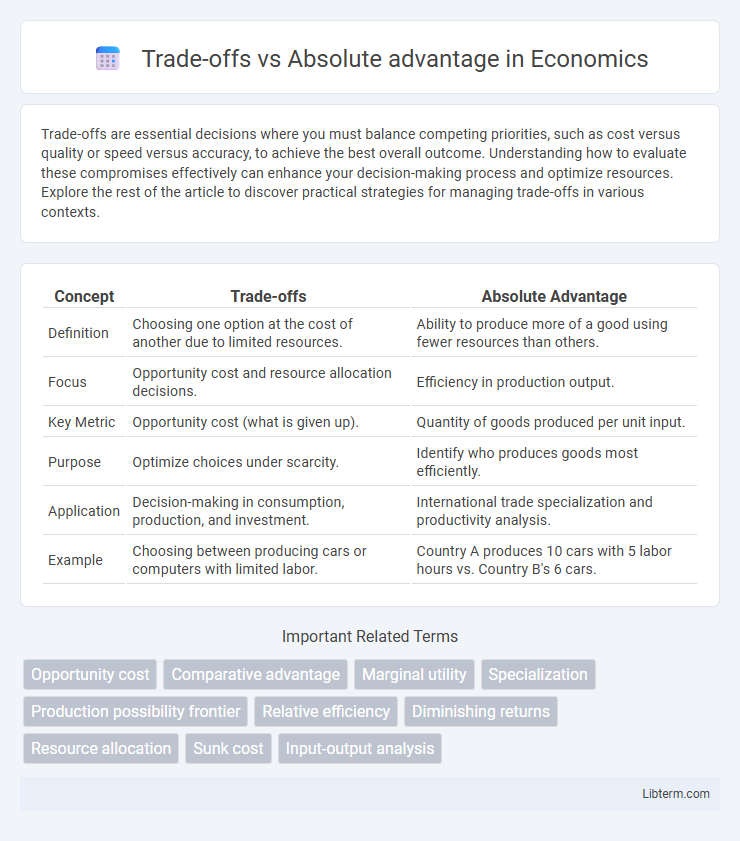Trade-offs are essential decisions where you must balance competing priorities, such as cost versus quality or speed versus accuracy, to achieve the best overall outcome. Understanding how to evaluate these compromises effectively can enhance your decision-making process and optimize resources. Explore the rest of the article to discover practical strategies for managing trade-offs in various contexts.
Table of Comparison
| Concept | Trade-offs | Absolute Advantage |
|---|---|---|
| Definition | Choosing one option at the cost of another due to limited resources. | Ability to produce more of a good using fewer resources than others. |
| Focus | Opportunity cost and resource allocation decisions. | Efficiency in production output. |
| Key Metric | Opportunity cost (what is given up). | Quantity of goods produced per unit input. |
| Purpose | Optimize choices under scarcity. | Identify who produces goods most efficiently. |
| Application | Decision-making in consumption, production, and investment. | International trade specialization and productivity analysis. |
| Example | Choosing between producing cars or computers with limited labor. | Country A produces 10 cars with 5 labor hours vs. Country B's 6 cars. |
Understanding Trade-Offs in Economics
Understanding trade-offs in economics involves recognizing the opportunity cost when choosing one option over another, highlighting the limited resources available for production. Trade-offs require evaluating the benefits of producing different goods or services, which contrasts with absolute advantage that focuses on the ability of a party to produce more efficiently. This concept helps businesses and countries optimize resource allocation by balancing costs and benefits rather than solely maximizing output.
Defining Absolute Advantage
Absolute advantage refers to a country's ability to produce a good or service more efficiently than another, using fewer resources or at a lower cost. This concept highlights the maximum output a producer can achieve with a given set of inputs, distinguishing it from trade-offs, which involve sacrificing some production to gain in another area. Understanding absolute advantage is crucial for identifying efficient production opportunities within international trade.
Key Differences Between Trade-Offs and Absolute Advantage
Trade-offs involve sacrificing one resource or opportunity to gain another, emphasizing the cost of decision-making, whereas absolute advantage refers to the ability of an entity to produce a good or service more efficiently than others. Trade-offs highlight opportunity costs and efficient resource allocation, while absolute advantage centers on superior productivity and output levels. Understanding trade-offs aids in prioritizing scarce resources, whereas recognizing absolute advantage helps identify specialization and potential gains from trade.
How Trade-Offs Influence Economic Decisions
Trade-offs influence economic decisions by requiring individuals and nations to allocate limited resources in a way that maximizes overall benefit, often prioritizing goods or services where they hold a comparative advantage. When making production choices, understanding opportunity cost helps identify the most efficient use of resources, leading to specialization and improved economic efficiency. This balance between trade-offs and absolute advantage ensures resources are not wasted on less productive activities, promoting optimal growth and trade benefits.
The Role of Absolute Advantage in Global Trade
Absolute advantage drives global trade by enabling countries to produce goods more efficiently than others, reducing production costs and increasing overall output. When nations specialize based on absolute advantage, they maximize resource utilization and enhance competitive positioning in international markets. This specialization fosters higher productivity and economic growth by leveraging unique efficiencies in labor, technology, or natural resources.
Real-World Examples of Trade-Offs vs Absolute Advantage
Trade-offs occur when countries must choose between producing goods using limited resources, such as the United States allocating labor to either technology or agriculture, sacrificing output in one sector to enhance the other. Absolute advantage is evident when a country can produce a good more efficiently than another, like Saudi Arabia's ability to extract oil at lower costs compared to many countries. Real-world examples demonstrate that while Saudi Arabia holds an absolute advantage in oil production, the U.S. faces trade-offs by balancing technology innovation and agricultural output to maximize overall economic benefit.
Impacts on Resource Allocation and Efficiency
Trade-offs in resource allocation highlight the opportunity cost of choosing one productive activity over another, influencing how resources are distributed to maximize overall efficiency. Absolute advantage emphasizes using resources in sectors where productivity is highest, promoting optimal allocation by focusing on the most efficient producers. Understanding the balance between trade-offs and absolute advantage allows economies to improve resource efficiency by aligning production decisions with comparative strengths and minimizing inefficiencies.
Limitations of Focusing Only on Absolute Advantage
Focusing solely on absolute advantage overlooks the benefits of specialization and comparative advantage, limiting trade efficiency. It ignores scenarios where a country may produce goods less efficiently but still gains from trade by concentrating on lower opportunity costs. This narrow perspective restricts understanding of global trade dynamics and mutual gains from exchange.
Strategic Decision-Making: Balancing Trade-Offs and Advantages
Strategic decision-making requires careful evaluation of trade-offs and absolute advantage to optimize resource allocation and competitive positioning. Trade-offs highlight opportunity costs when choosing between alternative investments, while absolute advantage emphasizes efficiency in producing specific goods or services. Balancing these factors enables firms to maximize overall value and sustain long-term growth in dynamic markets.
Future Implications for International Trade Theory
Trade-offs highlight opportunity costs in resource allocation, influencing comparative advantage and shaping international trade patterns by driving specialization and efficiency. Absolute advantage emphasizes productivity differences, encouraging countries to focus on industries where they excel, yet future trade theory must integrate both concepts to address evolving global supply chains and technology-driven shifts. Incorporating trade-offs and absolute advantage enables more nuanced models predicting how emerging economies and advanced technologies will transform competitive dynamics and trade policies.
Trade-offs Infographic

 libterm.com
libterm.com